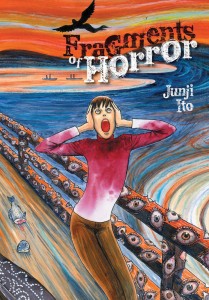By Junji Ito. Released in Japan by Asahi Shinbunsha, serialized in the magazines Nemuki+ and Shinkan. Released in North America by Viz.
I’ve never read Junji Ito before this volume, believe it or not. I used to say it’s because I don’t like horror, but I think we know that’s pretty much a lie. The truth is that I like horror if I can find an in, such as the characters and humor (Kurosagi CDS), the promise of a happy ending for these sweet kids (Higurashi), and seeing a well-crafted cast be horrible to each other (Umineko). So I never really thought about reading Uzumaki and Gyo. Reading this, though, I can see the appeal – the stories are not so much scary as unnerving, and while I didn’t feel particularly frightened as I read the book, I got more unnerved as I went along, and it sticks with you long after you put it down.
In an afterword, Ito talks about the fact that he hadn’t done a short story collection in a while, and feels the first one was rather weak. I’m inclined to agree with him, it’s the weakest in the book. In fact, the book almost succeeds in having each story be better than the previous one, though I think its peak for sheer disturbing is Blackbird, the tale of an injured hiker and the creature who helps him survive. And I will admit, there is some grotesque humor to be found here as well, from the woman who loves the house she’s boarding in – literally – to the entirely of Magami Nanakuse, which seems to combine grotesque horror and stand-up comedy in a way I can’t quite explain. Those expecting your typical American slasher story… or even Japanese titles like Ringu… are going to be startled, as this isn’t much like those.
It helps that Ito’s style of drawing faces and expressions hearkens back to a 1980s style rather than the more modern or cute manga styles we see today. Actually, a lot of his work reminded me of Makoto Kobayashi, author of What’s Michael and Club 9, who also enjoyed drawing long-faced, highly expressive men and women doing very, very silly things. I can also see fans of Furuya Usumaru liking this as well – the cover art is very reminiscent of one of his “Short Cuts” collages.
It’s hard to review a short story anthology without giving everything away, but I will note there were a few stories that went more for the melancholy than the creepy. Gentle Goodbye was sweet and sad, and makes you wonder what a world where this is possible would be like. It also has the most likeable viewpoint character of the series. And Whispering Woman was sad in a different, more sinister way, as we see someone desperately trying to deal with an abusive relationship, with tragic results. But really, the best thing to say about this collection is that I think even non-horror fans would get something out of it, though I’d certainly keep it away from young children (there’s also some nudity here, mostly in the story Wooden Spirit). Ito is a master, this book shows you why.

